How Constructivist Environment Changes Perception of Learning: Physics Is Fun
Abstract
:1. Introduction
Motivation: “Physics Was Not My Favorite Subject”
The mandate of schools is to unfold the personality of every student and to build a strong character with a sense of responsibility for democracy and community. This implies developing skills of reflection, interpretation of different information and other complex meta-competences.
The arrival of the Newtonian universe, was attractive, liberating and even comforting to many of those in the 17th and 18th centuries; it promised that the world was not the chaotic, confusing and threatening place it seemed to be—ruled by occult powers and full of enigmatic events—but was simple, elegant and intelligible. Newton’s work helped human beings to understand in a new way the basic issues that human beings seek: what they could know, how they should act and what they might hope for.[6]
2. Need for New Approaches
2.1. Hyper-Constructivism
To understand is to discover, or reconstruct by rediscovery, and such conditions must be complied with if in the future individuals are to be formed who are capable of production and creativity and not simply repetition.[25]
The effectiveness of inquiry-based learning depends on the guidance provided by teachers. An unguided or minimally guided inquiry may not work for students who have less previous knowledge or ability in the subject area. When the demands of the learning activities exceed students’ abilities, their learning is blocked and they may develop misunderstandings about the topic.
We do have average and below average teachers who actually don’ t have the skills to run discussion groups. I think that it is quite a high level skill for teachers. […] Teachers need to be confident enough to accept that they may not know the answers, this may […] discourage some teachers from allowing the situation to occur in the first place.
It is not enough for students just to hear explanations from experts (e.g., teachers, books, films, computers); they also need to practice using the ideas for themselves. ’The’ answers to ’the’ questions need to become ’their’ answers to ’their’ questions.
2.2. Neo-Realism: Objects and Multimedia
We anticipated that this prior exposure would motivate students to apply existing information and expand on their perceived knowledge. In addition, we sought to dispel existing misconceptions through class discussion and evaluation of previously held concepts. […] Students are more receptive to learning science when they can directly relate the material to real-life situations and events.

3. Teaching Environments
3.1. Primary School: States of Matter and Electricity
3.2. Physics as a Playground
3.3. Interactive Lectures for Schools
3.4. Working with Teachers
3.5. Lessons for Wide Public
3.6. Projecting Scientific Exhibitions
- -
- On movement and energy at “Hevelianum Center” (2009), as previously mentioned;
- -
- An interactive exhibition on physics and the history of optics “Fiat Lux—playing with light. From Vitelo to optical tomograph” with 20 editions all over Poland and 100,000 visitors (2009–2012);
- -
- Exhibitions on sounds (at the national congress of the Polish Physical Society in 2003, and a remake in 2023), and so on.
3.7. Constructivistic Text-Books
4. Discussion
5. Conclusions
Author Contributions
Funding
Institutional Review Board Statement
Informed Consent Statement
Data Availability Statement
Conflicts of Interest
References
- Sheer, A.; Noweski, C.; Meinel, C. Transforming Constructivist Learning into Action: Design Thinking in education. Des. Technol. Educ. Int. J. 2012, 17, 8–19. [Google Scholar]
- Rovelli, C. L’ordine del Tempo; Adelphi: Milan, Italy, 2017. [Google Scholar]
- Hawking, S.; Penrose, R. The Nature of Space and Time; Princeton University Press: Princeton, NJ, USA, 1996. [Google Scholar]
- Ransford, H.C. The Far Horizons of Time: Time and Mind in the Universe; de Gruyter: Berlin, Germany, 2015. [Google Scholar]
- Galileo, G. Dialogo dei Massimi Sistemi; Oscar Mondadori: Milan, Italy, 1996. [Google Scholar]
- Crease, R.P. Critical point. The quantum moment. Phys. World 2013, 26, 25. [Google Scholar] [CrossRef]
- Osborne, J.; Shirley, S.; Collins, S. Attitudes towards science: A review of the literature and its implications. Int. J. Sci. Educ. 2003, 25, 1049–1079. [Google Scholar] [CrossRef]
- Rocard, M.; Csermely, P.; Jorde, D.; Lenzen, D.; Walberg-Henriksson, H.; Hemmo, V. Science Education Now: A Renewed Pedagogy for the Future of Europe; European Commission, Directorate-General for Research: Bruxelles, Belgium, 2007; Available online: https://www.eesc.europa.eu/sites/default/files/resources/docs/rapportrocardfinal.pdf (accessed on 3 February 2023).
- Polish Physical Society. Inquiry on the Status of Teaching Physics in Poland, October 2022. Available online: Ptf.net.pl (accessed on 2 February 2023).
- Polish Ministry of Education, Central Examination Board, Warsaw. Maturity Exam (Formula 2014, Physics). Details. Available online: https://cke.gov.pl/images/_EGZAMIN_MATURALNY_OD_2015/Informacje_o_wynikach/2014/sprawozdanie/Fizyka.pdf (accessed on 6 January 2023).
- OECD. Creating Effective Teaching and Learning Environments: First Results from TALIS. Teaching and Learning International Survey. Available online: https://www.oecd.org/education/school/43023606.pdf (accessed on 2 February 2023).
- Jakubowski, M.; Patrinos, H.A.; Porta, E.E.; Wisniewski, J. The Impact of the 1999 Education Reform in Poland, OECD, EDU/WKP(2010)12. Available online: https://www.oecd-ilibrary.org/docserver/5kmbjgkm1m9x-en.pdf (accessed on 2 February 2023).
- Doherty, P. Scientific Explorations and Adventures. Available online: https://www.exo.net/~pauld (accessed on 29 January 2023).
- Karwasz, G.; Kruk, J. Idee I Realizacje Dydaktyki Interaktywnej—Wystawy, Muzea I Centra Nauki (Ideas and Realizations of Interactive Didactics—Exhibitions, Museums and Science Centres); Sci. Editions; University Nicolas Copernicus: Toruń, Poland, 2012. [Google Scholar]
- Susskind, L.; Friedman, A. Quantum Mechanics. The Theoretical Minimum; Italiana Raffaello Cortina Editore: Milano, Italy, 2015. [Google Scholar]
- Zichicchi, A. Perché io Credo in Colui che ha Fatto il Mondo; Il Saggiatore: Milano, Italy, 1999. [Google Scholar]
- Barrow, J.D.; Tipler, F.J. The Anthropic Cosmological Principle; Oxford University Press: Oxford, UK, 1988. [Google Scholar]
- Heller, M. Ostateczne Wyjaśnienie Wszechświata (The ultimate explanation of the universe); Universitas: Kraków, Poland, 2008. [Google Scholar]
- Michelini, M.; Stefanel, A.; Tóth, K. Implementing Dirac Approach to Quantum Mechanics in a Hungarian Secondary School. Educ. Sci. 2022, 12, 606. [Google Scholar] [CrossRef]
- Michelini, M.; Ragazzon, R.; Santi, L.; Stefanel, A. Proposal for quantum physics in secondary school. Phys. Educ. 2000, 35, 406. [Google Scholar] [CrossRef]
- Haszpra, T.; Kiss, M.; Izsa, É. RePLaT-Chaos-edu: An interactive educational tool for Replat-Chaos-edu: An interactive educational tool for secondary school students for the illustration of the spreading of volcanic ash clouds. J. Phys. Conf. Ser. 2021, 1929, 012079. [Google Scholar] [CrossRef]
- Karwasz, G. (Ed.) Physics and Toys. Virtual exhibition; Pomeranian Pedagogical Academy: Słupsk, Poland, 2005; Available online: https://dydaktyka.fizyka.umk.pl/zabawki1 (accessed on 6 January 2023).
- Akpan, J.P.; Lawrence, A.B. Using Constructivist Teaching Strategies to Enhance Academic Outcomes of Students with Special Needs. Univers. J. Educ. Res. 2016, 4, 392–398. [Google Scholar] [CrossRef]
- Potvin, P.; Abdelkrim, H. Interest, motivation and attitude towards science and technology at K-12 levels: A systematic review of 12 years of educational research. Stud. Sci. Educ. 2014, 50, 85–129. [Google Scholar] [CrossRef]
- Piaget, J. To Understand Is to Invent; Grossman: New York, NY, USA, 1973. [Google Scholar]
- Bruner, J.S. Acts of Meaning; Harvard University Press: Cambridge, MA, USA, 1990. [Google Scholar]
- Shulman, L.M. Knowledge and teaching: Foundations of the new reform. Harv. Educ. Rev. 1987, 57, 1–22. [Google Scholar] [CrossRef]
- Karwasz, G. Strategie dydaktyki kognitywistycznej: Hyper-konstruktywizm i neo-realizm. Podstawy teoretyczne. (Strategies of cognitivistic didactics: Hyper-constructivism and neo-realism. Theoretical basis). Stud. Eduk. 2021, 60, 113–134. [Google Scholar]
- Nesbit, J.; Liu, Q. Is Inquiry-Based Teaching Effective? Canadian Education Association, Simon Fraser University. Available online: https://www.edcan.ca/articles/is-inquiry-based-learning-effective (accessed on 2 January 2023).
- Newton, P.; Driver, R.; Osborne, J. The place of argumentation in the pedagogy of school science. Int. J. Sci. Educ. 1999, 21, 553–576. [Google Scholar] [CrossRef]
- Taber, K. What little they remember: Understanding science in the life-world. Stud. Sci. Educ. 2015, 52, 106–117. [Google Scholar] [CrossRef]
- Karwasz, G.; Kamińska, A. Constructivistic didactics in physics: Implementations. Acta Univ. Nicolai Copernic. Pedagog. 2020, 37, 185. [Google Scholar] [CrossRef]
- Karwasz, G.; Służewski, K.; Kamińska, A. Constructivistic Paths in Teaching Physics: From interactive experiments to step-by-step textbooks. Probl. Educ. 21st Century 2015, 64, 6–21. [Google Scholar] [CrossRef]
- Karwasz, G. Teaching sciences in early childhood—Inquiry-based, interactive path on energy. In Physics Alive; Lindell, A., Kahkonen, A., Viiri, J., Eds.; University of Jyvåskyla: Jyväskylän, Finland, 2012; pp. 68–73. [Google Scholar]
- Friedrichsen, P.; Van Driel, J.H.; Abell, S.K. Taking a closer look at science teaching orientations. Sci. Educ. 2010, 95, 358–376. [Google Scholar] [CrossRef]
- Tremblay, K.; Lalancette, D.; Roseveare, D. Testing Student and University Performance Globally: OECD’s AHELO. Available online: https://www.oecd.org/education/skills-beyond-school/AHELOFSReportVolume1.pdf (accessed on 2 February 2023).
- Knight, L.; Zollo, L.; McArdle, F.; Cumming, T.; Bone, J.; Ridgway, A.; Peterken, C.; Li, L. Drawing out critical thinking: Testing the methodological value of drawing collaboratively. Eur. Early Child. Educ. Res. J. 2014, 24, 320–337. [Google Scholar] [CrossRef]
- Berger, P.L.; Luckmann, T. The Social Construction of Reality. In A Treatise in the Sociology of Knowledge; Anchor Books: Garden City, NY, USA, 1966. [Google Scholar]
- Fazio, C.; Carpineti, M.; Faletič, S.; Giliberti, M.A.L.; Jones, G.; Mcloughlin, E.; Planinšič, G.; Rosario Battaglia, O. Strategies for Active Learning to Improve Student Learning and Attitudes towards Physics. In Teaching-Learning Contemporary Physics: From Research to Practice; Jarosievitz, B., Sükösd, C., Eds.; Springer: Berlin/Heidelberg, Germany, 2021; p. 213. ISBN 978-3-030-78719-6. [Google Scholar]
- Miller, K.; Lasry, N.; Chu, K.; Mazur, E. Role of physics lecture demonstrations in conceptual learning. Phys. Rev. Spec. Top. —Phys. Educ. Res. 2013, 9, 02011. [Google Scholar] [CrossRef]
- Dunlop, L.; Compton, K.; Clarke, L.; McKelvey-Martin, V. Child-led enquiry in primary science. Educ. Int. J. Prim. Elem. Early Years Educ. 2015, 43, 462–481. [Google Scholar] [CrossRef] [PubMed]
- Karwasz, G. Learning physics. The joy of scientific discovery. Stud. Educ. 2016, 3, 71–85. [Google Scholar]
- Garcia, R.; Rahman, A.; Klein, J.G. Engaging Non-Science Majors in Biology, One Disease at a Time. Am. Biol. Teach. 2015, 77, 178–183. [Google Scholar] [CrossRef]
- Energy is Magic, Video Clips. Available online: https://karwasz.edu.pl/quick-vids/#Energy-is-magic (accessed on 2 January 2023).
- Apollo 15. Hammer & Feather. Video clip. Available online: https://www.youtube.com/watch?v=03SPBXALJZI (accessed on 5 January 2023).
- Gangoli, S.G.; Gurumurthy, C. A study of the effectiveness of a guided open ended approach to physics experiment. Int. J. Sci. Educ. 1995, 17, 233. [Google Scholar] [CrossRef]
- Sullivan, S.; Gnesdilow, D.; Puntambekar, S.; Kim, J.-S. Middle school students’ learning of mechanics concepts through engagement in different sequences of physical and virtual experiments. Int. J. Sci. Educ. 2017, 39, 1573–1600. [Google Scholar] [CrossRef]
- Kácovský, P.; Snětinová, M. Physics demonstrations: Who are the students appreciating them? Int. J. Sci. Educ. 2021, 43, 529–551. [Google Scholar] [CrossRef]
- Trumper, R. Energy and a constructivist way of teaching. Phys. Educ. 1990, 25, 208–212. [Google Scholar] [CrossRef]
- Fuchs, H.F.; Corni, F.; Pahl, A. Embodied simulations of forces of nature and the role of energy in physical systems. Educ. Sci. 2021, 11, 759. [Google Scholar] [CrossRef]
- Karwasz, G.; Sadowska, M.; Rochowicz, K. Toruński po-ręcznik do Fizyki (Torun’s Tex-Book for Physics); Wydawnictwo Naukowe Uniwersytetu Mikołaja Kopernika: Toruń, Poland, 2010. [Google Scholar]
- Sadowska, M.; Wyborska, K. Konstruktywizm w Praktyce Szkolnej—Toruński po-Ręcznik do Fizyki, (Constructivism in School Practice—Torun’s Tex-Book for Physics); Problemy Dydaktyki Fizyki: Czeszów, Wrocław, Poland, 2013; pp. 225–236. [Google Scholar]
- Rogers, E.M. Physics for the Inquiring Minds. In The Methods, Nature, and Philosophy of Physical Science; Princeton University Press: Princeton, NJ, USA; Oxford University Press: Oxford, UK, 1960. [Google Scholar]
- Amaldi, U.; Tibone, F. Fisica Interattiva. Meccanica, CD-ROM; Zanichelli Editore: Bologna, Italy, 1998. [Google Scholar]
- Franzuz-Ornat, G.; Kulawik, T.; Nowotny-Różańska, M. Spotkania z Fizyką (Meeting physics); Nowa Era: Warszawa, Poland, 2010. [Google Scholar]
- Akimkhanova, Z.Y.; Turekhanova, K.M.; Karwasz, G.P. Implementing EU interactive teaching methods at Al-Farabi Kazakh National University. J. Physics Conf. Ser. 2021, 1929, 012092. [Google Scholar] [CrossRef]
- Rhee, R.J. The Socratic Method and the Mathematical Heuristic of George Pólya, 81 St. John’s L. Rev. 881 (2007), University of Florida, Levin College of Law. Available online: http://scholarship.law.ufl.edu/facultypub/491 (accessed on 29 January 2023).
- Pang, K. Sophist or Socratic Teaching methods in fostering learning in US graduate education. Int. J. Learn. Annu. Rev. 2008, 15, 197–202. [Google Scholar] [CrossRef]
- Corni, F.; Michelini, M.; Colletti, L. Training Prospective Primary and Kindergarten Teachers on Electric Circuits Using Conceptual Metaphors. Educ. Sci. 2022, 12, 457. [Google Scholar] [CrossRef]
- Corni, F.; Fuchs, H.U. Primary Physical Science for Student Teachers at Kindergarten and Primary School Levels: Part I—Foundations of an Imaginative Approach to Physical Science. Interchang. 2020, 51, 315–343. [Google Scholar] [CrossRef]
- Kibble, B. How do you picture electricity. Phys. Educ. 1999, 34, 226. [Google Scholar] [CrossRef]
- Saxena, A.B. An attempt to remove misconceptions related to electricity. Int. J. Sci. Educ. 1992, 14, 157–162. [Google Scholar] [CrossRef]
- Mingle with Teachers in Physics on Stage. Le Bulletin du CERN. No. 44/2000—Lundì 30 Octobre 2000. Available online: https://cds.cern.ch/journal/CERNBulletin/2000/44/News%20Articles/44449?ln=fr (accessed on 3 February 2023).
- Giliberti, M. Stories and Theatre for Teaching Physics at Primary School. Educ. Sci. 2021, 11, 696. [Google Scholar] [CrossRef]
- Karwasz, G. Scienza e Fede. Un Breve Manuale; Aracne Editrice: Roma, Italy, 2019. [Google Scholar]
- Karwasz, G. Mały Astronom. Przewodnik po Kosmosie (Little Astronomer. Guide through Cosmos.); Publicat: Poznań, Poland, 2022. [Google Scholar]
- Alberti, M. Planeta Matemático. Un Viaje Numérico por el Mondo; RBA Colaccionables: Barcelona, Spain, 2012. [Google Scholar]
- Corchio Orrit, R. Galileo-Il Metodo Scientifico. La Natura si SCRIVE IN FORMula; RBA: Milano, Italy, 2013. [Google Scholar]
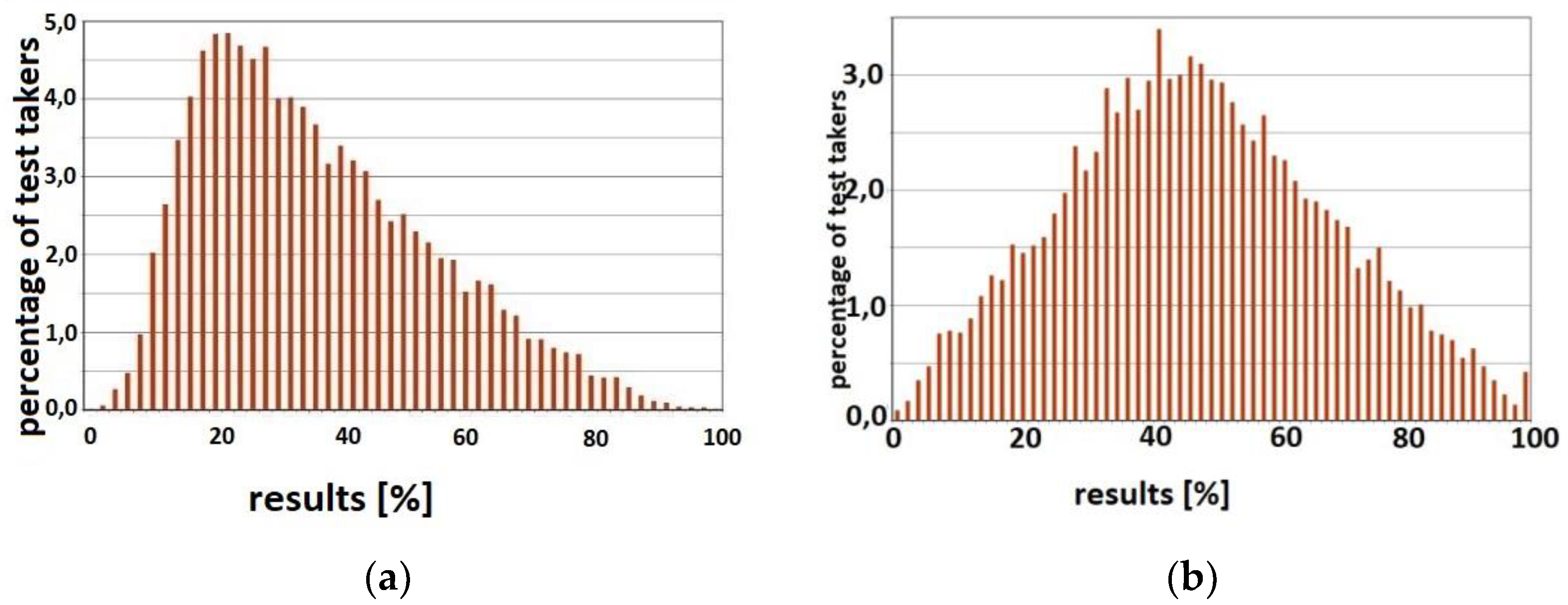

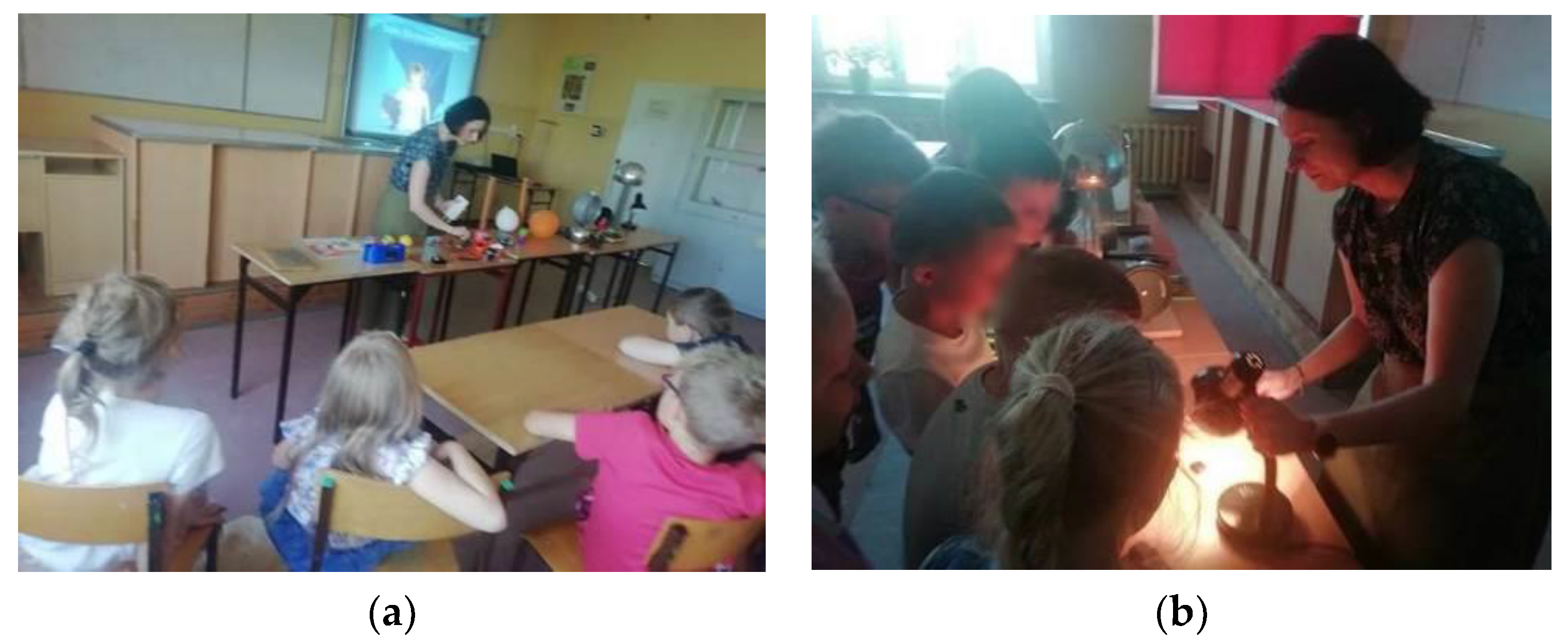

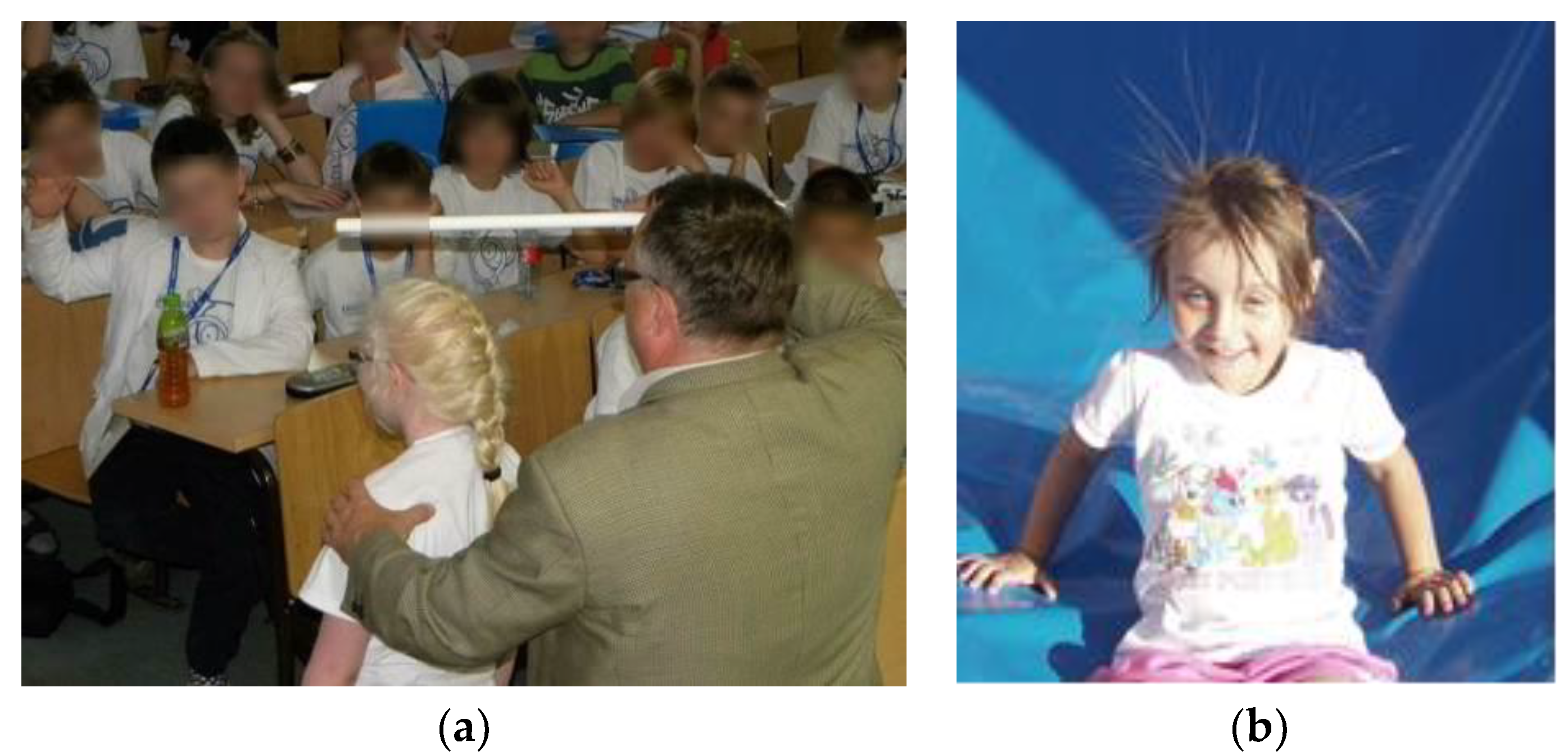

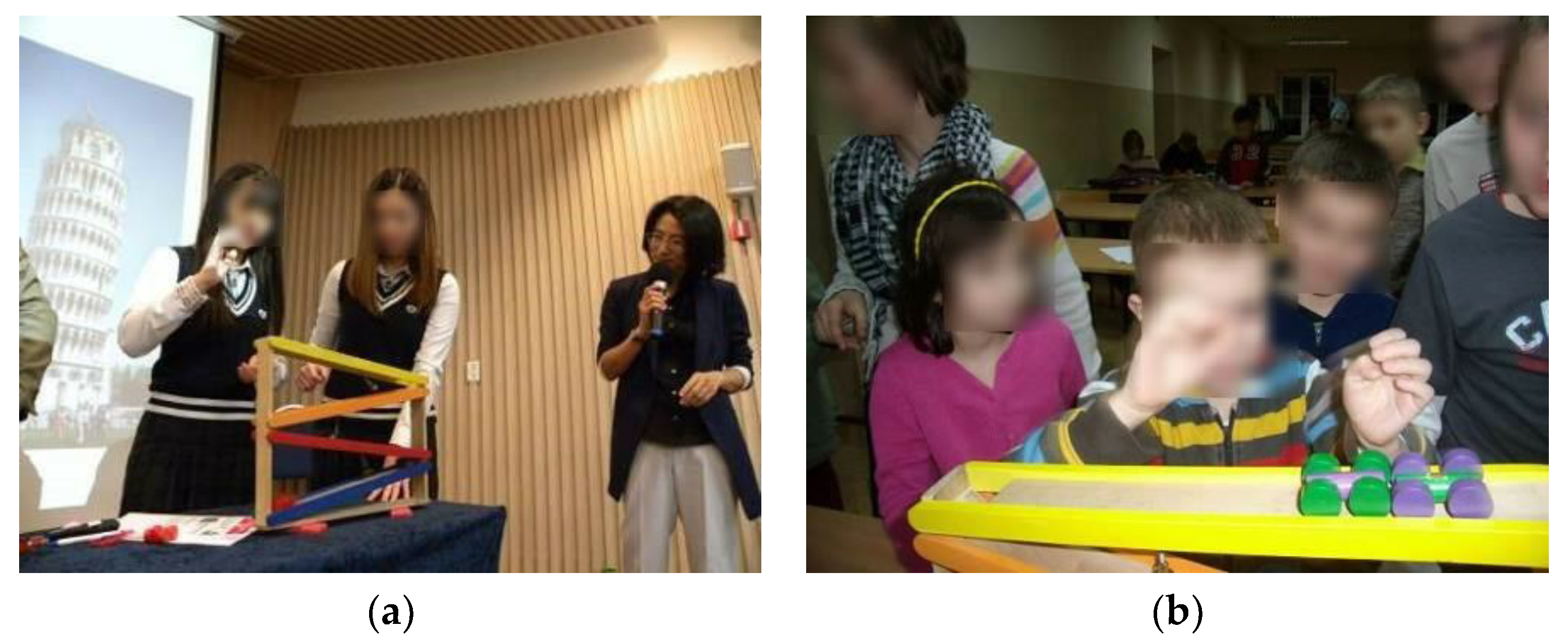
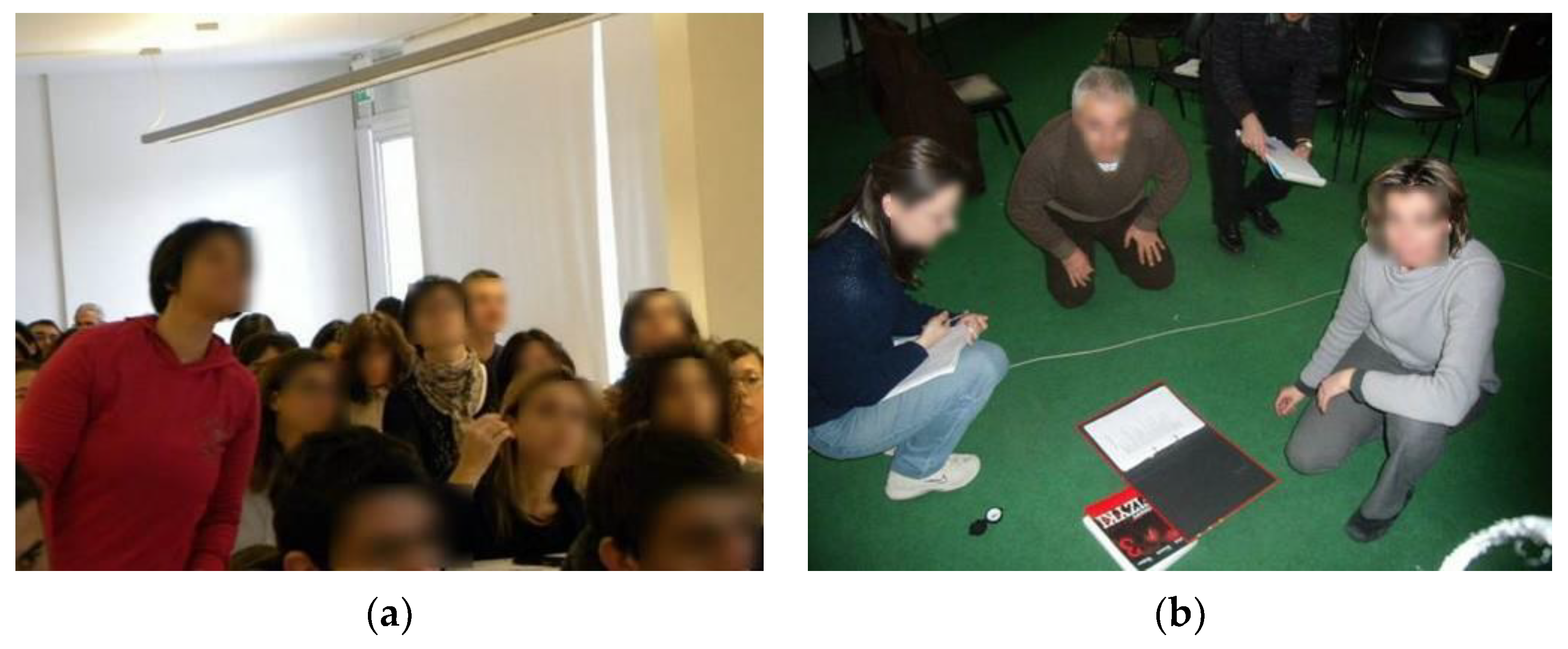
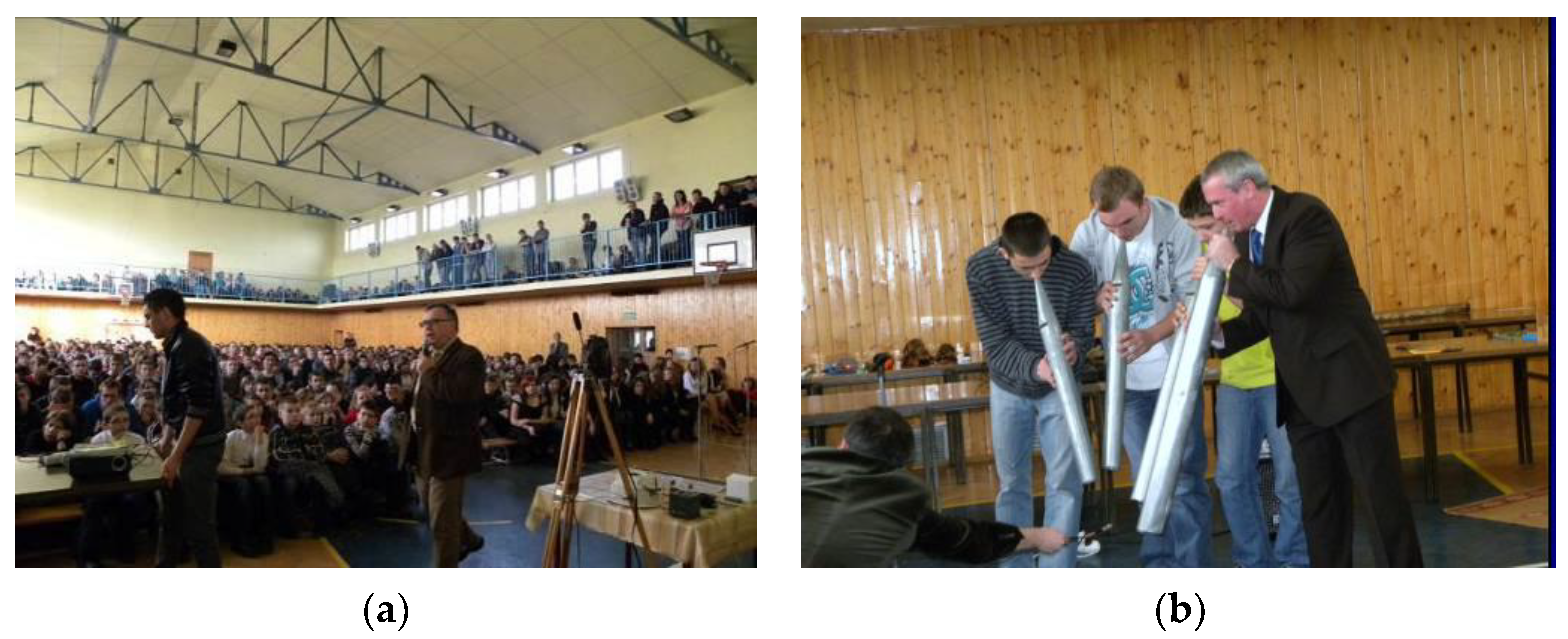



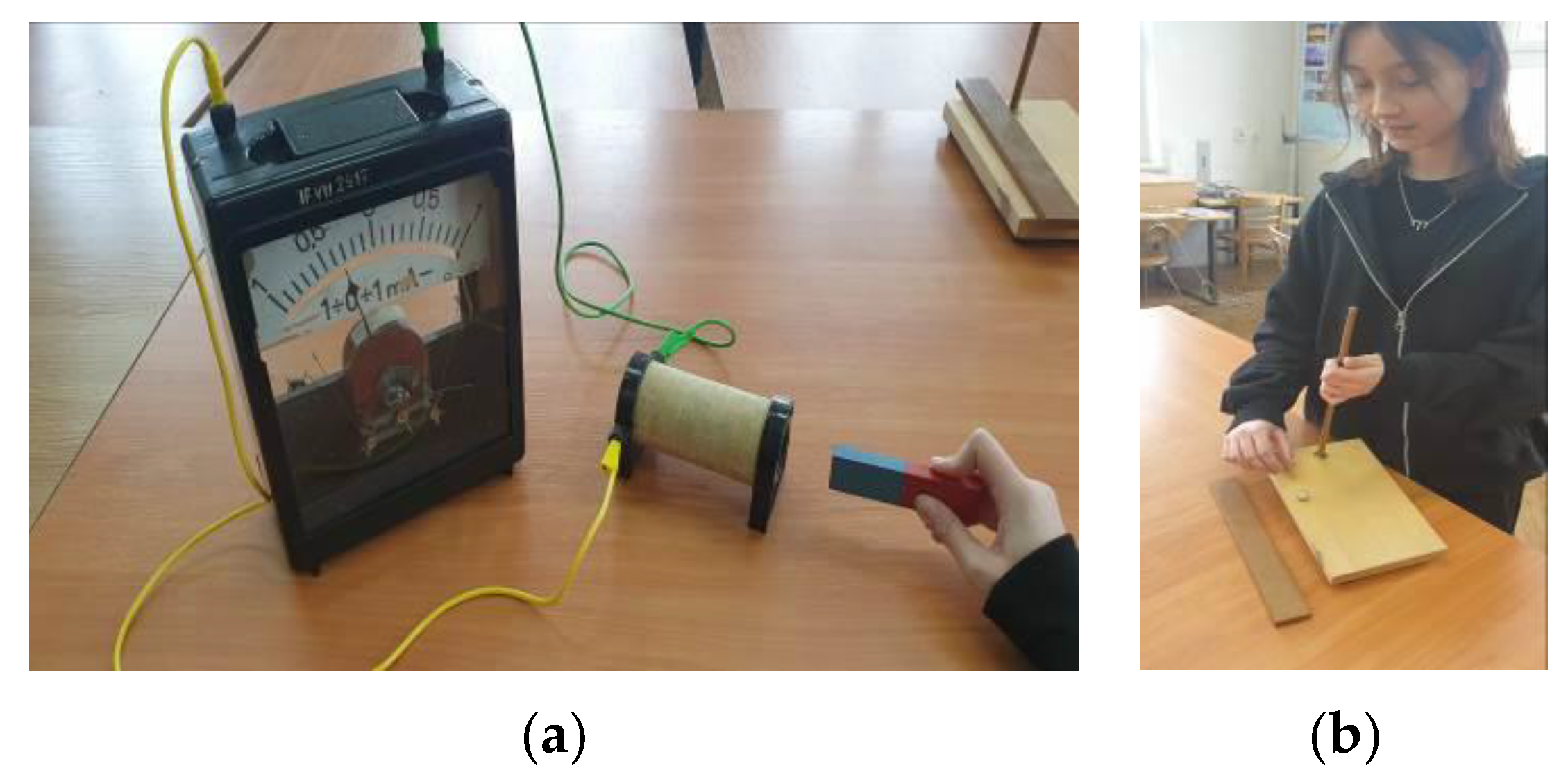

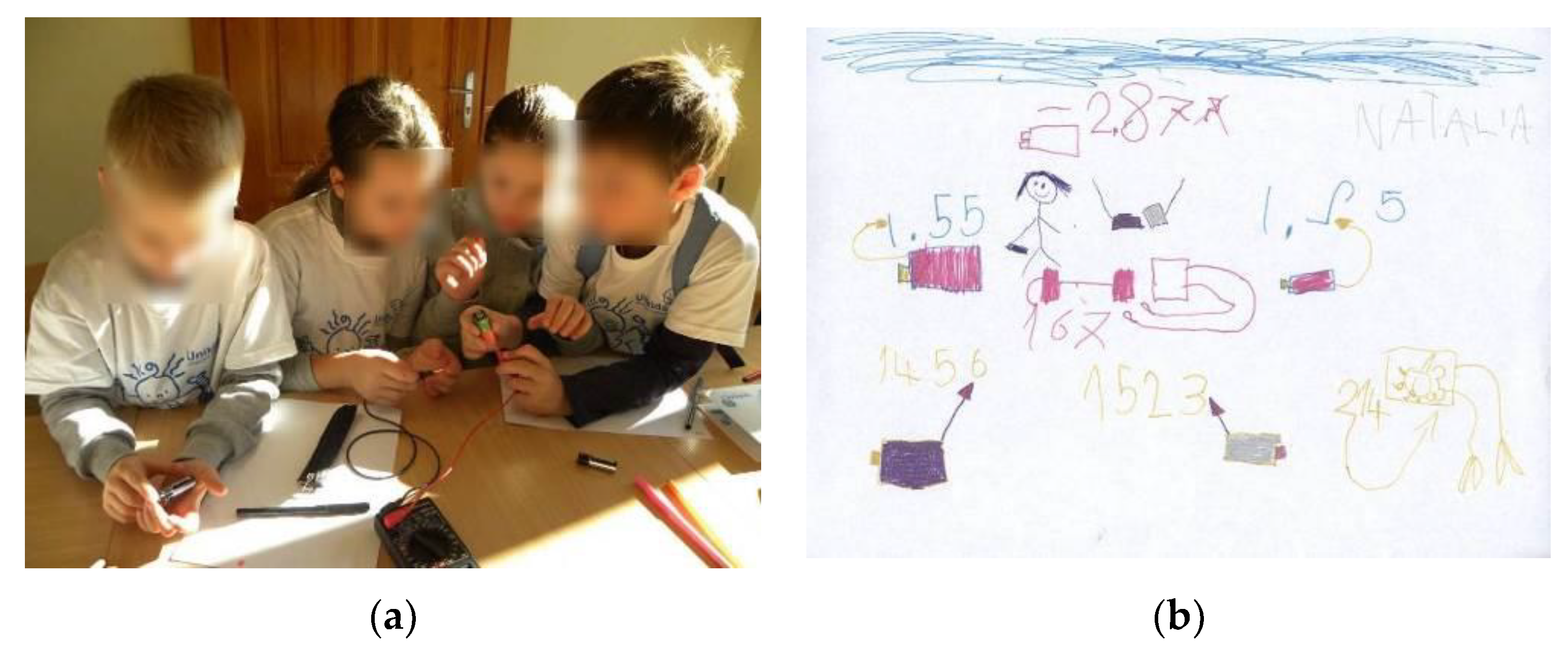
Disclaimer/Publisher’s Note: The statements, opinions and data contained in all publications are solely those of the individual author(s) and contributor(s) and not of MDPI and/or the editor(s). MDPI and/or the editor(s) disclaim responsibility for any injury to people or property resulting from any ideas, methods, instructions or products referred to in the content. |
© 2023 by the authors. Licensee MDPI, Basel, Switzerland. This article is an open access article distributed under the terms and conditions of the Creative Commons Attribution (CC BY) license (https://creativecommons.org/licenses/by/4.0/).
Share and Cite
Karwasz, G.P.; Wyborska, K. How Constructivist Environment Changes Perception of Learning: Physics Is Fun. Educ. Sci. 2023, 13, 195. https://doi.org/10.3390/educsci13020195
Karwasz GP, Wyborska K. How Constructivist Environment Changes Perception of Learning: Physics Is Fun. Education Sciences. 2023; 13(2):195. https://doi.org/10.3390/educsci13020195
Chicago/Turabian StyleKarwasz, Grzegorz P., and Katarzyna Wyborska. 2023. "How Constructivist Environment Changes Perception of Learning: Physics Is Fun" Education Sciences 13, no. 2: 195. https://doi.org/10.3390/educsci13020195
APA StyleKarwasz, G. P., & Wyborska, K. (2023). How Constructivist Environment Changes Perception of Learning: Physics Is Fun. Education Sciences, 13(2), 195. https://doi.org/10.3390/educsci13020195






